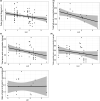Diets maintained in a changing world: Does land-use intensification alter wild bee communities by selecting for flexible generalists?
- PMID: 35600696
- PMCID: PMC9108308
- DOI: 10.1002/ece3.8919
Diets maintained in a changing world: Does land-use intensification alter wild bee communities by selecting for flexible generalists?
Abstract
Biodiversity loss, as often found in intensively managed agricultural landscapes, correlates with reduced ecosystem functioning, for example, pollination by insects, and with altered plant composition, diversity, and abundance. But how does this change in floral resource diversity and composition relate to occurrence and resource use patterns of trap-nesting solitary bees? To better understand the impact of land-use intensification on communities of trap-nesting solitary bees in managed grasslands, we investigated their pollen foraging, reproductive fitness, and the nutritional quality of larval food along a land-use intensity gradient in Germany. We found bee species diversity to decrease with increasing land-use intensity irrespective of region-specific community compositions and interaction networks. Land use also strongly affected the diversity and composition of pollen collected by bees. Lack of suitable pollen sources likely explains the absence of several bee species at sites of high land-use intensity. The only species present throughout, Osmia bicornis (red mason bee), foraged on largely different pollen sources across sites. In doing so, it maintained a relatively stable, albeit variable nutritional quality of larval diets (i.e., protein to lipid (P:L) ratio). The observed changes in bee-plant pollen interaction patterns indicate that only the flexible generalists, such as O. bicornis, may be able to compensate the strong alterations in floral resource landscapes and to obtain food of sufficient quality through readily shifting to alternative plant sources. In contrast, other, less flexible, bee species disappear.
Keywords: Bee decline; biodiversity exploratories; foraging; metabarcoding; pollen nutrients; solitary bees.
© 2022 The Authors. Ecology and Evolution published by John Wiley & Sons Ltd.
Conflict of interest statement
The authors declare no conflict of interest.
Figures


References
-
- Amiet, F. , Hermann, M. , Müller, A. , & Neumeyer, R. (2017). Fauna Helvetica‐ Apidae 1‐6. (C. SEG Ed.).
-
- Barton, K. (2019). MuMIn:Multi‐model inference. R package version 1.43.6. Retrieved from https://CRAN.R‐project.org/package=MuMIn
-
- Bates, D. , Mächler, M. , Bolker, B. , & Walker, S. (2015). Fitting linear mixed‐effects models Using lme4. Journal of Statistical Software, 67(1). 10.18637/jss.v067.i01 - DOI
-
- Biesmeijer, J. C. , Roberts, S. P. M. , Reemer, M. , Ohlemüller, R. , Edwards, M. , Peeters, T. , Schaffers, A. P. , Potts, S. G. , Kleukers, R. , Thomas, C. D. , Settele, J. , & Kunin, W. E. (2006). Parallel declines in pollinators and insect‐pollinated plants in Britain and the Netherlands. Science (New York, N.Y.), 313, 351–354. 10.1126/science.1127863 - DOI - PubMed
LinkOut - more resources
Full Text Sources

